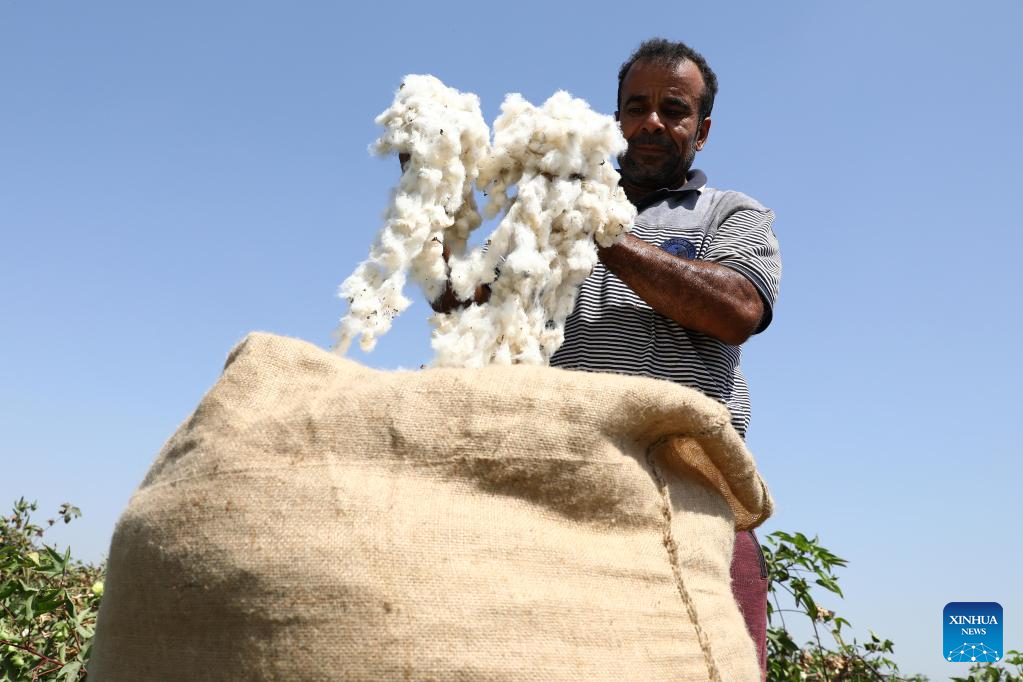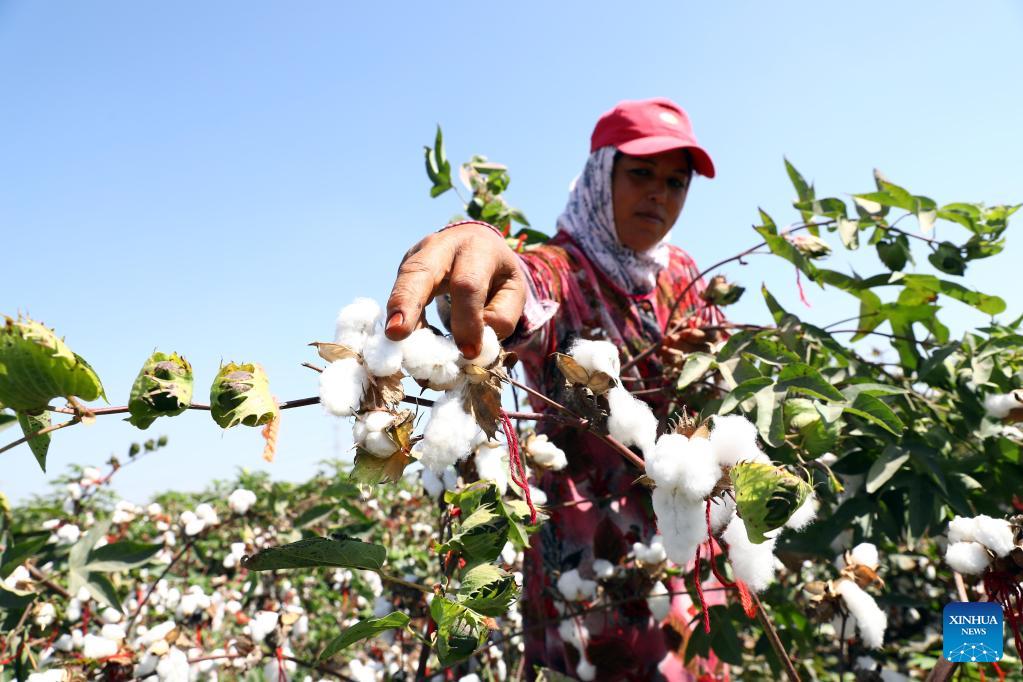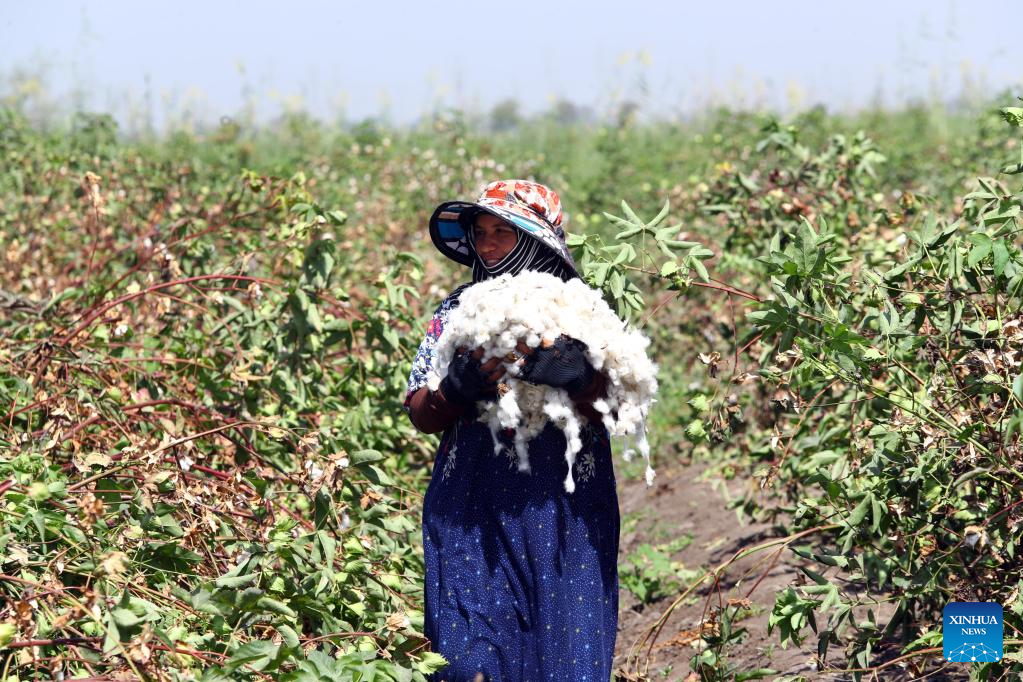
A man collects harvested cotton at a farm in Kafr El-Sheikh, Egypt, Sept. 28, 2022.
Bathed in the warm sun and pleasant breezes of the Mediterranean, cotton bolls bloomed on the research farm of Sakha Agricultural Research Station in Kafr El-Sheikh in the Nile Delta region of northern Egypt, turning the land into a white blanket.(Xinhua/Ahmed Gomaa)
by Mahmoud Fouly
KAFR EL-SHEIKH, Egypt, Oct. 19 (Xinhua) -- Bathed in the warm sun and pleasant breezes of the Mediterranean, cotton bolls bloomed on the research farm of Sakha Agricultural Research Station in Kafr El-Sheikh in the Nile Delta region of northern Egypt, turning the land into a white blanket.
A dozen of cotton pickers were hard at work, removing the bolls from cotton plants and putting them into small bags. On the side of the field, huge burlap sacks of cotton piled up like a small hill.
Two varieties of cotton were grown on the research farm, Giza 97, one of the most cultivated cotton varieties in Egypt, and Giza 93, one of the best cotton varieties in the world in terms of quality.
This year's harvest on the farm will provide Egyptian agrotechnicians with the information to further improve the breeding and cultivation of the two cotton varieties.
Salah Saber, leader of the cotton seed breeding team at the research farm, said that agrotechnicians' hard efforts have made a significant contribution to the production of top-quality cotton, on which Egypt takes great pride.
"We have succeeded in breaking the negative correlation between the cotton yield and quality, and managed to get both at the same time," he said.
He explained that a feddan (0.42 hectare) of cotton, which used to produce about 7 to 8 kantars (a kantar equals 45.02 kilos) of seed cotton, now produces about 12 to 13 kantars, thanks to the cotton breeding research.
Egypt's Central Agency for Public Mobilisation and Statistics (CAPMAS) reported that the export of Egyptian cotton in the previous cotton season, which started in September 2020 and ended in August 2021, reached 1.7 million kantars.
The CAPMAS data also showed that cotton production in the Arab world's most populous country reached 2.3 million kantars in the 2020/2021 season, a 31-percent increase over the 2019/2020 season.
Saber said that the boom in cotton production is driven by both Egypt's plans to expand the cultivation of the cash crop and improve cotton breeding and cultivating technologies.
Egypt's agrotechnicians have been seeking to create cotton varieties that satisfy the demands of farmers in terms of yield, those of merchants in terms of the quantity of lint produced, and those of the global market in terms of quality, staple length, fiber strength and softness, Saber added.
Samar Salem, a cotton picker, said that she was happy to work in the farm, whose research will bring benefits to the country's cotton industry and improve the living condition of millions of Egyptian farmers. ■

A woman harvests cotton at a farm in Kafr El-Sheikh, Egypt, Sept. 28, 2022.
Bathed in the warm sun and pleasant breezes of the Mediterranean, cotton bolls bloomed on the research farm of Sakha Agricultural Research Station in Kafr El-Sheikh in the Nile Delta region of northern Egypt, turning the land into a white blanket.(Xinhua/Ahmed Gomaa)

A woman carries harvested cotton at a farm in Kafr El-Sheikh, Egypt, Sept. 28, 2022.
Bathed in the warm sun and pleasant breezes of the Mediterranean, cotton bolls bloomed on the research farm of Sakha Agricultural Research Station in Kafr El-Sheikh in the Nile Delta region of northern Egypt, turning the land into a white blanket.(Xinhua/Ahmed Gomaa)
